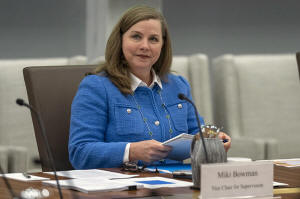Inflation or jobs: Federal Reserve officials are divided over competing
concerns
[August 15, 2025] By
CHRISTOPHER RUGABER
WASHINGTON (AP) — One major question will be front and center for
Federal Reserve policymakers as they prepare for an annual conference in
Jackson, Wyoming next week and a crucial policy meeting in September:
Which is a bigger problem for the economy right now, stubborn inflation
or slower hiring?
Weak job gains since April have pushed some officials toward supporting
a cut in the Fed’s key rate as soon as next month, but speeches and
comments by other Fed policymakers show that inflation is still a
concern.
That could make the Fed's ultimate move at its September 16-17 meeting a
close call. There will be another jobs report and another inflation
report before then, and both will likely heavily influence the decision
of whether to cut or not. The uncertainty also means that Fed Chair
Jerome Powell's speech next Friday in Jackson will be closely watched
for any clues about next steps.
If Fed officials worry more that unemployment will start to rise and the
economy falter, they are more likely to reduce their rate in order lower
borrowing costs and spur borrowing and spending. Yet if their concerns
grow that inflation will stay high or worsen as tariffs ripple across
global supply chains, they will lean more towards keeping borrowing
costs high to cool the economy and lower prices. The rate currently
stands at 4.3%.
Wall Street investors are pretty certain — for now — that the central
bank will reduce rates in September, with futures prices putting the
odds of a cut at 93%, according to CME Fedwatch.

Those odds jumped after the monthly jobs report Aug. 1 showed that
hiring was sluggish in July and was much lower than previously estimated
in May and June. Average job gains over those three months fell to just
35,000, down from 123,000 a year ago.
And Tuesday's inflation report, which showed only a mild pickup in
inflation at the consumer level and limited signs that tariffs were
pushing goods prices higher, underscored the view of some officials that
they could put inflation concerns aside and focus on shoring up the job
market instead.
“With underlying inflation on a sustained trajectory toward 2%, softness
in aggregate demand, and signs of fragility in the labor market, I think
that we should focus on risks to our employment mandate,” Michelle
Bowman, a member of the Fed's governing board, said last week.
Yet Austan Goolsbee, president of the Federal Reserve's Chicago branch,
downplayed the weakness in hiring in remarks to reporters Wednesday. The
slowdown in job gains could partly reflect the drop in immigration
stemming from President Donald Trump's border crackdown, Goolsbee said,
rather than a weaker economy. He also pointed to the still-low
unemployment rate of 4.2% as evidence that the job market is solid.
This week's inflation report included some warning signs, Goolsbee
added: Prices of many services that aren't affected by tariffs, such as
dental care and air fares, jumped, a sign that inflation may not be in
check.
“That was the most concerning thing in the inflation report, and if that
persisted, we would have a hard time getting back to 2%,” Goolsbee said,
referring to the central bank's inflation goal. "I am still hopeful that
will not be a lasting problem.”

[to top of second column] |

Michelle Bowman, Vice Chair for Supervision of the Federal Reserve
Board of Governors, takes a seat for an open meeting of the Board of
Governors at the Federal Reserve, in Washington, June 25, 2025. (AP
Photo/Mark Schiefelbein, File)
 Fed officials also disagree on how
tariffs will affect inflation going forward. Many increasingly
believe the duties will result in simply a one-time boost to prices
that will quickly fade and not lead to ongoing inflation.
“Tariffs will boost inflation in the near term, but likely not in a
persistent way” that would require the Fed to keep rates elevated,
Mary Daly, president of the Fed's San Francisco branch, said in a
recent speech.
Daly also said the labor market has “softened" and suggested the Fed
“will likely need to adjust policy in the coming months.”
However, Raphael Bostic, president of the Fed's Atlanta branch, said
Wednesday that the tariffs could lead to longer-term inflation if
they cause more manufacturers to shift output from lower-cost
locations overseas back to the United States, or to other countries
with higher wages. Such a change would be more than just a one-time
shift.
“You’re going to see fundamental structural changes if this is
successful," Bostic said in remarks in Red Bay, Alabama. “It is
actually a different economy.”
In that scenario, Bostic said, he would prefer to wait “until we
have a little more clarity." And he added that with unemployment
low, “we have the luxury to do that.”
Thursday's July wholesale price report, which showed a sharp jump in
goods and services prices before they reach the consumer, did make
one move less likely: A half-point cut in September, as suggested by
Treasury Secretary Scott Bessent.
Alberto Musalem, president of the Fed's St. Louis branch, who votes
on Fed policy this year, said that a reduction of that size is
“unsupported by the current state of the economy, and the outlook
for the economy," in an interview on CNBC.

Tim Duy, an economist at SGH Macro, said Thursday that the Fed may
have to raise its inflation forecast at its September meeting when
it provides its latest set of quarterly economic projections. The
central bank's policymakers currently expect inflation, excluding
volatile food and energy, to reach 3.1% by the end of this year, yet
inflation is already near that level.
Cutting rates at the September meeting would be hard for the Fed if
it is also forecasting higher inflation, Duy said.
“There are things that could happen that would push the Fed off the
path" toward a rate cut, he said. “We’re not paying adequate
attention to those risks.”
All contents © copyright 2025 Associated Press. All rights reserved |